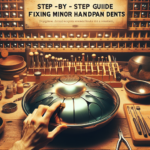The handpan is a relatively new musical instrument that has captured the imagination of musicians and audiences alike. Known for its ethereal tones and meditative qualities, it is often favored for its seemingly effortless ability to create beautiful music. However, beneath the surface lies an intricate art of mastering complex rhythmic patterns that can elevate a player from novice to virtuoso.
The Origin and Evolution of the Handpan
The handpan, often referred to as a “hang drum” due to its resemblance to a wok or UFO, was first developed in the early 2000s. It was inspired by other percussion instruments like the steelpan from Trinidad and Tobago. The instrument consists of two metal hemispheres glued together, with tuned notes applied using a hammering technique. Despite its relatively short history, the handpan has rapidly grown in popularity and diversity, creating a rich tapestry of playing styles and techniques.
Basic Handpan Techniques
Before diving into complex rhythms, it is essential to master the basic techniques. The handpan is played using the hands and fingers, where different parts of the hand (such as the pads, tips, and knuckles) are used to strike various areas of the instrument. Here are some foundational techniques:
- Slap: A quick stroke using the pads of the fingers or the palm to produce a sharp, resonant sound.
- Tone Field Strike: Basic hitting of the note areas (tone fields) on the handpan to produce a clear, melodic sound.
- Gu Strike: Striking the central hole, or ‘Gu,’ to create lower, bass-like tones.
- Muting: Controlling the ringing or resonance by lightly touching a note after or during a strike.
Understanding Rhythmic Complexities
Rhythmic complexity in handpan playing often involves the coordination between different patterns played simultaneously or in a sequence. It is the challenge of weaving these rhythms together that creates a captivating musical experience. Here are some key concepts to grasp:
- Polyrhythms: The use of two or more conflicting rhythms simultaneously. For example, integrating a 3/4 time signature with a 4/4 pattern.
- Syncopation: Deliberate placement of beats or accents where they are not usually expected, creating a sense of surprise or off-beat rhythm.
- Odd Time Signatures: Time signatures that are atypical, such as 5/4 or 7/8, which provide a “push-pull” feel to the rhythm.
Practicing Complex Rhythmic Patterns
Mastering complex rhythmic patterns requires time, dedication, and a structured approach to practice. Here is a step-by-step method that can help:
- Internalize the Beat: Begin by practicing with a metronome set to a slow tempo. Feel the rhythm in your body, sway or tap your foot to internalize the beat.
- Break it Down: Decompose the pattern into smaller, more manageable segments. Practice each segment individually before combining them.
- Layering: Start by playing the base rhythm with one hand, and then slowly introduce additional layers with the other hand. This could be simple taps or more complex patterns.
- Gradual Speed Increase: Slowly increase the tempo on the metronome as you become comfortable with the patterns. Ensure each increase is precise and clean.
- Record and Reflect: Record your practice sessions to evaluate your progress. Listen for timing errors, excessive ringing, or uneven strikes, and adjust accordingly.
Incorporating Musicality
Technical proficiency is essential, but incorporating musicality – the emotive and expressive elements – is what truly brings handpan playing to life. Here’s how to infuse your playing with emotion:
- Dynamic Control: Vary the volume and intensity of your strikes to create crescendos (gradual increases in volume) and decrescendos (gradual decreases).
- Phrasing: Think of each rhythmic pattern as a sentence or phrase. Play with intentional pauses, accelerations, or variations to tell a musical story.
- Tonal Variation: Experiment with different areas of the handpan to discover new sounds and nuances. Layer these tones to create a rich, textured soundscape.
The Role of Improvisation
Improvisation is a crucial aspect of handpan playing. It allows for freedom of expression and personalizes the music. Here are some tips to improve your improvisational skills:
- Begin with familiar patterns and gradually introduce variations.
- Listen to a wide range of music for inspiration and new ideas.
- Utilize silence and space effectively – sometimes the absence of sound can be as impactful as a note.
- Record your improvisations to track your progress and identify areas for improvement.
Conclusion
The art of mastering complex rhythmic patterns on the handpan is both a challenging and deeply rewarding endeavor. By understanding the foundational techniques, exploring rhythmic complexities, and incorporating personal expression, a handpan player can create truly mesmerizing music. The journey of mastering the handpan is an ongoing process, requiring patience, practice, and a willingness to explore uncharted territory. Nonetheless, it is a path filled with opportunities for creative growth and profound musical expression.





